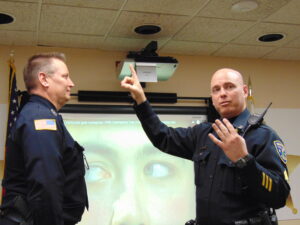Belvidere Citizen’s Police Academy: Part 5
By Anne Eickstadt

ANNE EICKSTADT PHOTO Belvidere Daily Republican
Sgt. Washburn demonstrates the nystagmus test, the first DUI test usually applied in field-testing, with the assistance of Officer Blankenship.
Editor
Postponed a week to accommodate instructor scheduling conflicts, the course on DUI Enforcement has finally had its opportunity. Sergeant Chris Washburn, DUI trainer and dayshift patrol supervisor, is leading this class. “Our expert on DUI enforcement,” said Deputy Chief Matthew Wallace. He has been on the BPD force for 16 years and has made approximately 140 driving-under-the-influence arrests.
“DUI is a complex investigation,” Washburn said. “It involves what the officer is seeing, smelling, and hearing. Writing the report has to include everything because the officers are the only witness to the DUI. If you can get really proficient at recording a DUI report, you can do anything.
“A DUI report is more complex than a murder investigation. With a murder, there are so many people recording parts of the case that there are plenty of witnesses to what happened and a single paragraph may be all I need to turn in. I have never turned in a DUI report that is less than three pages long.
“Every day 28 people in the United States die in alcohol related vehicle crashes. Drunk driving crashes claim more than 13,000 lives each year. DUI caused deaths and damages, including property damage, hospital expenses, and funerals, contribute to a cost of over $44 billion per year.
“Of the 1132 traffic deaths among children aged 14 or younger, 209, or 16 percent, involve an alcohol impaired driver.
“In 2015, nearly 1.1 million drivers were arrested for DUI or narcotics impairment. That is only one percent of the 111 million self-reported incidents of DUI. Nearly three in ten fatal accidents involved impaired drivers with blood alcohol levels over .08 percent. Nearly three in ten of those drivers were also between 21 and 24 years old.
The best chance of reducing these numbers is education. Some of the best groups out there are:
MADD – Mothers Against Drunk Driving
SADD – Students Against Destructive Decisions
TADD – Teens Against Drunk Driving
AAIM – Alliance Against Intoxicated Motorists
IDDPA – International Drunk Driving Prevention Association
“Law Enforcement’s ultimate goal is to increase DUI deterrents and decrease alcohol-related crashes, injuries, and deaths. Belvidere has a reputation for stopping cars for any reason from aberrant behavior to seat belt violations to burned out license plate lights. We want to deter DUIs and keep the community safe.”
Field sobriety tests are a battery of tests used by police officers to determine if a person suspected of impaired driving is intoxicated with alcohol or drugs. The US National Highway Traffic Safety Administration (NHTSA) began research in 1975 on how to test suspects for impaired driving. The NHTSA developed a series of tests that police officers could use when evaluating suspected impaired drivers By 1981, officers in the United States began using the organization’s battery of standardized sobriety tests to help make decisions about whether to arrest suspected impaired drivers. The tests were designed to indicate intoxication associated with a blood alcohol concentration (BAC) of 0.10%. After some US states began lowering their BAC limits to 0.08%, a study was done to see if the battery could be used to detect BACs at or above 0.08% and above and below 0.04%. This was done to deal with the changes in the laws that led to lower legal BAC limits across the US.
“In 1995, scientists in San Diego, Cal. contacted police across the country to find out how they determined if a driver was alcohol impaired. They correlated all the information and started whittling it down to commonalities. Then they started their own tests. Guys in lab coats tested each other, ‘It’s your turn to get drunk,’ to determine the most accurate tests for impairment.
“They came up with three phases of DUI detection in the form of the Field Sobriety Tests which are now universally used by law enforcement officers. The tests were refined in Colorado in 1996 and again in Florida in 1998.
“When I am on patrol and come across a possible DUI, I have to rely on my senses and experience to observe the totality of the circumstances.
“1.) Observation of the vehicle in motion. Is there a moving violation, equipment violations, other violations, unusual operation, or anything else that alerts me? Then I have a decision to make: Do I stop the vehicle? I also observe their stopping sequence: Do they stop immediately or take a while? Was there an abrupt weave or attempt to flee? Do they stop in the street, by the curb, over the curb, or in someone’s backyard?
“2.) Personal contact. Interview and observation of the driver – what do I see? What do I hear? What do I smell? Then I have a decision to make: Should I have the driver exit. Then I observe the exit: Do they have trouble standing up? Do they grab for support? Did they just light a cigarette or douse themselves in perfume to mask the odor of alcohol? Are their clothes soiled? Do they have slurred speech?
“3.) Pre-arrest screening: Then comes the three phase Standardized Field Sobriety Testing which are recognized by the National Highway Traffic Safety Administration. These include Horizontal Gaze Nystagmus – involuntary jerkiness in the eyes; the Walk and Turn, and a One Leg Stand.”
The first test that is typically administered is the
For complete article, pick up the March 14 Belvidere Daily Republican.


